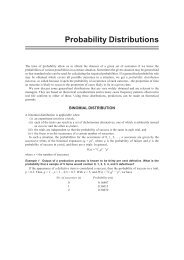International-Business-Dr-R-Chandran-E-book
International-Business-Dr-R-Chandran-E-book
International-Business-Dr-R-Chandran-E-book
You also want an ePaper? Increase the reach of your titles
YUMPU automatically turns print PDFs into web optimized ePapers that Google loves.
Assumptions of Heckscher-Ohilin Theory<br />
230<br />
<strong>International</strong> <strong>Business</strong>- <strong>Dr</strong>. R. <strong>Chandran</strong><br />
1. The theory is based on a 2 × 2 × 2 model. It takes in to consideration<br />
that there are two countries, two commodities and two factors of<br />
production.<br />
2. Transport costs or other impediments to trade are not taken in to<br />
account. This assumption applies that the prices of commodities under<br />
trade will be the same in both the countries.<br />
3. The Theory assumes the existence of perfect competition in both the<br />
commodity and factor markets. This implies that both capital and<br />
labour are perfectly mobile in respective country, and would move<br />
from low paying industries in to high paying ones. Perfect<br />
competition in the commodity market implies that neither a<br />
monopolistic nor oligopolistic environment prevails.<br />
4. All production factors are homogeneous in degree, specially it expects<br />
returns to scale in production of each commodity in each country. For<br />
example a 10 percent increase in factor inputs in each industry results<br />
in exactly 10 percent output in that industry.<br />
5. The production functions are such that the two commodities show<br />
different factor intensities. This means that different combinations of<br />
factors or production techniques are used in different industries. The<br />
goods ‘Y’ may be capital intensive while the goods ‘X’ may be labour<br />
intensive. Goods that are labour intensive will always remain labour<br />
intensive irrespective of relative changes in the price of labour.<br />
6. The production function differs between two commodities but<br />
nevertheless remain same in both the countries. Thus the production<br />
techniques and factors intensity used in producing goods ‘Y’ in<br />
country A is the same as that is used in producing goods ‘X’ in<br />
country B. the same is true about production function for goods ‘X’ in<br />
country A and B. This implies that the best available techniques are<br />
known to both the countries and are used in the price of labour.<br />
7. The theory assumes that full employment resources exists in both the<br />
countries so that production takes place on the same point on the<br />
production possibility curve and not somewhere below it.<br />
8. It also assumes that preferences and technology levels do not change.<br />
Practically, technology has become accessible to anyone both<br />
indigenous and internationally. Germany, Japan and USA have proved<br />
their high levels of technology in medical equipments, entertainment<br />
electronics and chemicals & drugs respectively. Today, productivity is<br />
Only for Private Circulation





